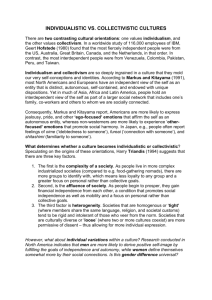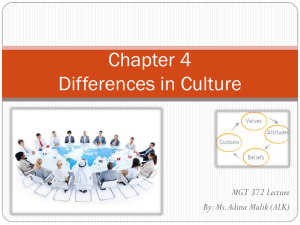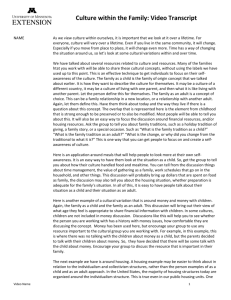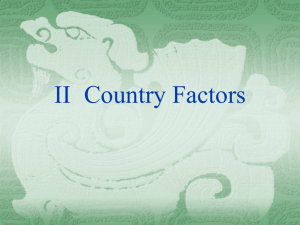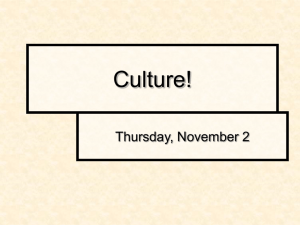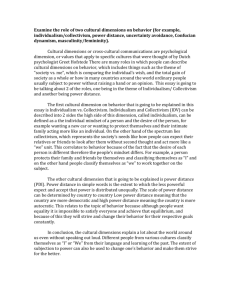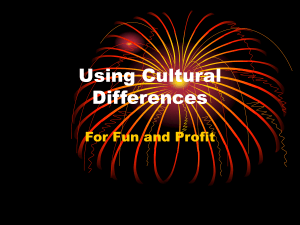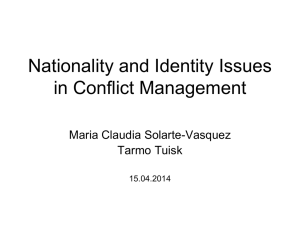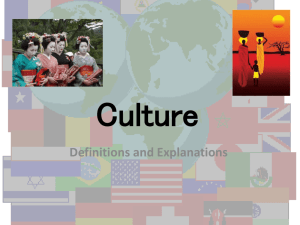Culture
advertisement
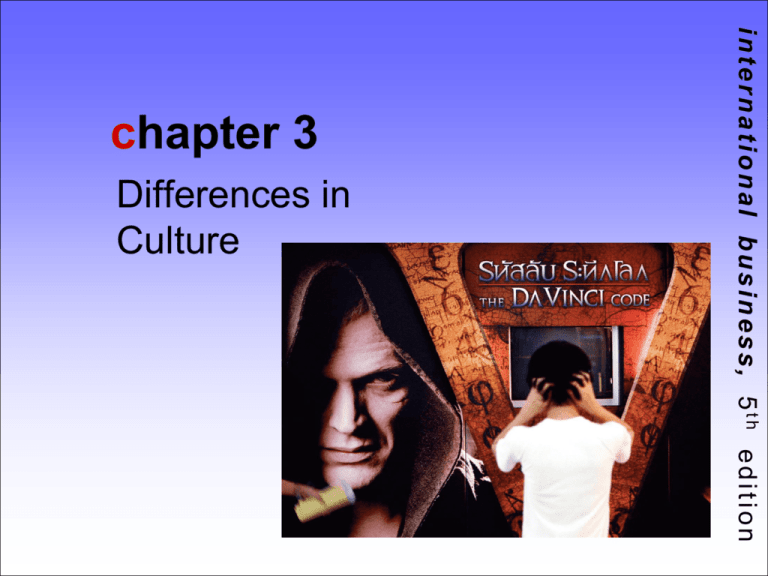
Differences in Culture international business, 5th edition chapter 3 Chapter Objectives 1 • What is culture and society • Forces leading to differences in culture • Identify the business and economic implications of differences in culture • Understand how differences in social culture influence values in the workplace • Understand the economic and business implications of cultural change 4-2 McDonald's in India Did you look at the case in page 86-87? What is the ideas behind this case? Cross-cultural communication? World economic development 2010 http://hdr.undp.org/en/media/HDR_2010_A R_Complete_reprint.pdf 4-3 Introduction • McDonald’s customization • What is means? cross-cultural literacy • You need to understand cultural differences • Play the culture rules and do as Romans do but if you have to and you are there. 4-4 Introduction • MacDonald’s do not sell Bacon in Muslim countries. 4-5 Culture 4-6 • http://www.youtube.com/watch?feature=endscreen&NR=1&v=ha ohj1sVnyk • http://www.youtube.com/watch?v=loL97DgsvdE • http://www.youtube.com/watch?v=RVmFsGp9FV4&feature=relat ed • http://www.youtube.com/watch?v=cB2qo9uAAjU&feature=relate d Culture • Communication is a way to understand other’s culture. • Insha-Allah • The culture of generosity. • Gift might be misunderstood and rejected in some cultures 4-7 Culture defined • Stick to Namenwrith and Weber and Hofestede: • Culture is a system of values and norms that are shared among a group of people and that when taken together constitute a design for living. 4-8 Define it • Values: abstract ideas about what a group believes to be good, right, and desirable. • It is shared assumptions about how things ought to be 4-9 Culture • Norms: the social rules and guidelines that prescribe appropriate behaviours in particular situations. Our guests are here you should greet them this is our norm. Part of our value of respect. 4-10 Society • Society is a group of people who share a common set of values and norms. • Examples of values: freedom, justice, honesty, integrity, credibility....etc. 4-11 Culture • Norms: norms guide your actions. • It is a norm here to say inshallah for an appointment with another person. • It is a norm to come 5 to 10 minutes late for that meeting. 4-12 Culture, society, and the nation state • Culture has sub-cultures. • Society got multiple society. • Muslim culture • America culture • Indian culture • When you get closer you find many cultures inside each one and many societies as well 4-13 What determines culture? See figure 3.1 page 91 • Social structure • Religion and ethical systems • Language • Education • Economic and political philosophy 4-14 Figure 4.1 Elements of Culture Language Social structure Education Culture Economical And political 4-15 These elements interact with each other Religion Social Structure Individuals, families, and groups Social stratification (class) - Britain & India social structure Social mobility (class) 4-16 • Societies differ in the role of family, individuals and relationship of individuals with each other and with the group. • In some societies individualism is high and is promoted. international business, 5th edition Social structure 2 • Social stratification: It has to do with social classes. • Factors used in stratification: occupation, income, level of education, birth. • Some societies are highly stratified, whereas others are less stratified. • In highly stratified societies social mobility(moving from one stratum to another) is not easy. international business, 5th edition Social structure 3 Individualism • Individualism emphasizes individual performance • Individualism leads to entrepreneurship • Creating new products- the case of Steve jobs. 4-19 Individualism • Individualism commitment is to the self, the individual not to the company. • No lifetime career for managers in the US. • Theory Z by William Ouchi • 4-20 http://www.enotes.com/theory-z-reference/theory-z-176920 The group and the TEAM • I versus WE • Me versus US 4-21 Social Stratification • Hierarchy • Social mobility: the extent to which individuals can move out of the strata into which they are born. You can not marry her, she does not belong to our strata or social class. • In Japan- middle class 4-22 Significance • The stratification is significant if it affects the operation of business. • In the US social mobility and individualism limit the impact of class background on business operations. • Social equality- low industrial disputeslow cost of production leading to high global competitive advantage 4-23 Language • An important means by which a society’s members communicate. • 3000+ different languages10,000+ different dialects (worldwide). • Presence of more than one language reflects diversity of the population. India is an example. • Linguistic ties can facilitate trade. USA, Uk., Australia…etc. (competitive advantage).Colonial relationships also have some impact. • French language in North Africa!!!!!!!!! • Un spoken means what? 4-24 international business, 5th edition Language 2 • English is the most popular language in IB. why? • Knowledge of foreign languages is an added advantage. • Translation can overcome linguistic differences. Back-translation may be used. But we should be careful. Word placement or misuse of vocabulary could change the meaning. • Examples: • Leave your values at the desk • WE will execute customers in strict rotation Map 4.1 World Languages 4-26 Map 4.2 Africa’s Colonial Legacy 4-27 Religion • Imposes constraints on roles of individuals in society • Religion shapes attitudes, working days, consumption, the types of products consumers may purchase. • Varies from country to country 4-28 Religion Christianity Islam Judaism Hinduism Buddhism Confucianism 4-29 Map 4.3 Major World Religions 4-30 Religion More than Two million Muslims annually descend on the Grand Mosque in Mecca, Saudi Arabia as part of the Hajj. 4-31 Economic implications of Confucianism The impact of 1.Loyalty 2.Reciprocal obligations 3.Honesty in dealing with others The above lead to trust in relationships 4-32 Education • Education and individual competencies (self fulfilment ...etc.) • Education and national competitive advantage • Education and international business. 4-33 Education • In KSA and the Middle East • In Japan and Korea • what Porter says about education in Japan after the wwII • Japan’s only endowment (resource) is its human capital. 4-34 Education • Education and IB • India is following and bypassing Japan in this factor. • Outsourcing and education- no one is going to place production operation in poor education country. 4- • You can never market books to illiterate nation or country. Culture and the workplace • IB, culture, and the workplace • Management practices are affected somehow by the national culture. • So culture is related to values in the workplace. 4-36 Hofstede’s Four Dimensions Research Method • IBM • 100,000 participants • 1967- 1973 • 40 countries 4-37 Hofstede’s Four Dimensions Power Distance Uncertainty Orientation Individualism Vs Collectivism Masculinity Vs femininity 4-38 Social Orientation Individualism Collectivism Relative importance of the interests of the individual versus interests of the group 4-39 • The extent to which less powerful members of organizations accept the unequal power distribution. • People in high-power distance societies are more likely to accept the authority of superiors, respect authority, and position in the hierarchy. international business, 5th edition Power Orientation : Power distance Power Orientation Power Respect Power Tolerance Appropriateness of power/authority within organizations 4-41 • Extent to which people feel threatened by ambiguous situations. • People coming from uncertainty avoidance cultures dislike ambiguity and try to avoid whenever possible. On the contrary, those coming from uncertainty tolerant cultures perceive it as a chance to grow and develop. Those are more acceptable for flexible hierarchies, rules and procedures. Risk taking is highly valued. international business, 5th edition Uncertainty Avoidance Uncertainty Orientation Uncertainty Acceptance Uncertainty Avoidance Emotional response to uncertainty and change 4-43 Masculinity Vs Femininity • Masculine culture: values such as achievement, and the exercise of power determined cultural ideals. • In feminine cultures, sex roles were less distinguished and little differentiation between men and women in the same job. 4-44 Culture Change • Culture evolves over time. • What makes culture change • Towards women • Towards collectivism • Loyalty- Japan- become like Westerners 4-45 Cultural change • Economy changes culture (rich) • As you get rich you move away from traditional values • Moving to the city. • Education, technology, and globalization. • Consumerism and civilization. 4-46 Chapter summary • McDonald’s customization • Page 88 what is cross cultural literacy and its importance • What is culture –page 89 • Define social structure • Individual vs collective impact on business and International business 4-47 Chapter summary • Social strata and business and IB. • Class system and social mobility • Significance page 96 • Religious systems- just what might enhance international relations and effective IB. 4-48 Chapter summary • Economic implications of Islampage 101 • Move from page 101 to 105 and read the economic implications of Confucianism. Three elements are important there. 4-49 Chapter summary • Move to page 108 and look at the role of education. See also what porter says about Japan and know that the most important secret behind nation’s development is education and compare between Egypt and south Korea. 4-50 Chapter summary • Geert Hofstede Study • Cultural change just page 111 and 112. • Use the slides as a guide if you can. • Study Wal-Mart case page 118. 4-51
